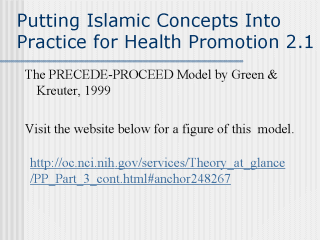| front |1 |2 |3 |4 |5 |6 |7 |8 |9 |10 |11 |12 |13 |14 |15 |16 |17 |18 |19 |20 |21 |22 |23 |24 |25 |26 |review |
 |
In one of
the most comprehensive theoretical model for health promotion intervention planning by
Green and Kreuter (1999), the PRECEDE-PROCEED theoretical model, some of the determinants
of behavior outlined include Predisposing factors, Enabling factors and Reinforcing
factors. By moving progressively through nine phases this model offers comprehensive
framework for planning a health promotion intervention. As mentioned earlier the
PRECEDE-PROCEED model has nine phases, the first five are diagnostic: (1) social
diagnosis of the self-determined needs, wants, resources, and barriers to them in the
target community; (2) epidemiological diagnosis of the health problems; (3) behavioral
and environmental diagnosis of the specific behaviors and environmental factors for
the program to address; (4) educational and organizational diagnosis of the
predisposing, enabling, and reinforcing conditions which immediately affect behavior; and
(5) administrative and policy diagnosis of the resources needed and available in
the organization, as well as the barriers and supports available in the organization and
community. The four remaining phases in PRECEDE-PROCEED are implementation and evaluation (process, impact, and outcome), with emphasis on using the latter to improve the former. Evaluation of the process begins as soon as implementation does, in order to detect problems early so they can be corrected. As implementation proceeds, the planner starts evaluating in the order in which program effects are expected. First, its immediate effects (impacts) are evaluated, in order to determine the extent to which the program needs modification. Finally, when enough time has passed--as specified in the objectives--the ultimate intended effects on morbidity, mortality, and quality of life are assessed. This kind of phased evaluation allows you to see what works and what does not. Reference: Green W. L. & Kreuter W. M. (1999). Health Promotion Planning: An Educational and Ecological Approach. 3rd ed. Mountain View. Mayfield Publishing Company. National Institute of health. |
| front |1 |2 |3 |4 |5 |6 |7 |8 |9 |10 |11 |12 |13 |14 |15 |16 |17 |18 |19 |20 |21 |22 |23 |24 |25 |26 |review |